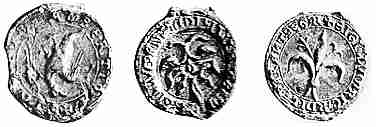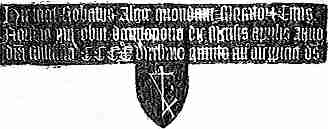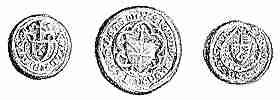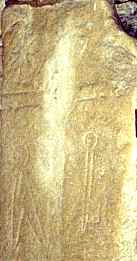




If you are looking at this page without frames, there is more information about medieval writing to be found by going to the home page (framed) or the site map (no frames).
| Seals of Townsmen and Merchants | ||||
| The nature of town life meant that people of all social classes required a seal to ratify various written legal processes. Apart from transactions and agreements, there were various forms of certification and licences. In fact, town life became as much tied up in written documentation as it is today. Well, perhaps not that much, but when we look at some of the more bizarre regulations concerning tradesmen and merchants, let us not scoff without comparing them against some of our own zoning regulations and tax laws. | ||||
| Some seals of townsmen bore the same kinds of animal or plant designs as are found on the seals of the rural gentry. | ||||
 |
||||
| Above left, two seals of aldermen of Oxford from a certificate of 1182: at right the seal of Richard cousin of Segari on an indenture of 1190 concerning a land transaction involving a tenement near the north gate of Oxford (Christ Church, Oxford). (From Salter, 1929) | ||||
| The seal on the left bears the design of a bird with spread wings, but it looks more like a duck than one of the more heraldic creatures. The centre one has an unidentified plant design while that on the right carries a fleur-de-lis. | ||||
| Town merchants had individual insignia which they used to identify themselves and their goods. These are known as merchants' marks and have certain qualities in common with heraldic devices, although operating in a different social environment. They were used to identify the goods of a particular merchant, but in the days when traders could do very well for themselves, they might evolve from mere trademarks to attributes of status. | ||||
 |
Rubbing of a funerary brass to Robert Asger, d.1425, with inscription and merchant's mark, from the church of St Laurence in Norwich. | |||
| Not surprisingly, merchants used their marks in the design of their seals. | ||||
 |
Seals of William Alsley 1365, Robert Whatton 1361 and Thomas de Narrington 1375. | |||
| The above examples of 14th century merchants' seals use merchants' marks in an almost heraldic presentation, and in fact, very much resemble some simpler heraldic seals of the time. The central example even has delicate Gothic tracery behind the shield bearing the merchant's mark. These little objects are quite fascinating as they encapsulate so many issues of the social life and social mobility of the time: merchants making good and climbing up the social tree, acquiring the traditional attributes of status of the old country aristocracy such as knighthoods, heraldic arms, grand country estates; at the same time members of the country gentry trying to raise their family status with a bit of dabbling in trade and moneymaking schemes in the towns so they can be more important at home. Nobody wanted to be a serf any more and tradespeople were moving into the towns. The king was still sitting on top his feudal heap while the vassals were throwing the social order into confusion. | ||||
 |
Some minor town officials or tradesmen depicted themselves in the process of doing their work. The matrices might be rough little objects, with the design scratched into wood or bone. The figure usually bore some attributes of his trade, like the tollkeeper here who looks to be holding out his purse invitingly. | |||
| Replica of the matrix of the 12th century seal of Snarre the tollkeeper, discovered in the upper layers of the Coppergate excavation in York. | ||||
| A simpler alternative was to depict only the tools of trade of an artisan; the scissors of a tailor or the chopper of a butcher or the adze of a carpenter. This form of depiction was also used on funerary slabs of the artisan classes. Such simple designs are not in themselves a protection against fraud or misuse, but they indicate that even the relatively humble members of town society were participating in the conduct of business through the written word, even if they could not write themselves. |  |
|||
| Funerary slab with incised designs of shears and a key on either side of a crucifix, re-used in the porch wall of the parish church of Bakewell in Derbyshire. | ||||
| These simpler seals are not so much depicted in books of fancy documents, but they would make a fascinating study as part of an investigation of town life of the middle ages. | ||||
|
|
||||
|
|
||||
|
If you are looking at this page without frames, there is more information about medieval writing to be found by going to the home page (framed) or the site map (no frames). |
||||